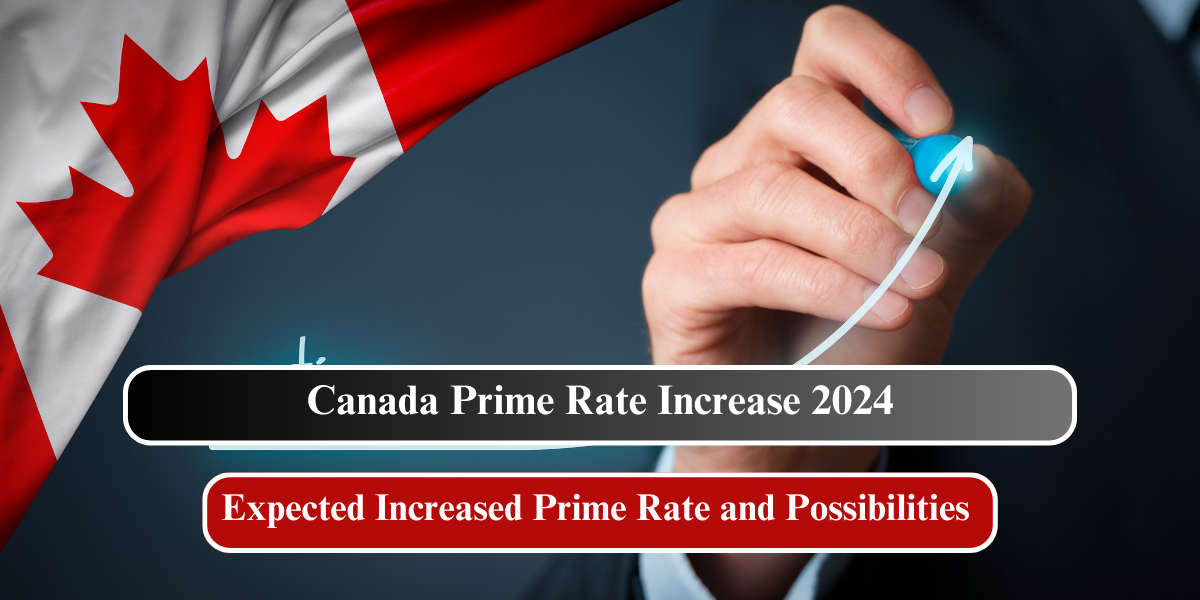This article will provide you with information about the Canada Prime rate increase 2024. Bank of Canada does not change its prime rate of 7.20 percent, which includes variable rates offered by lenders. The central bank of Canada has not hinted at rates that are signaled by hikes in inflation and rising costs. The mortgage rates are rising and the prime rate is a perfect example. Continue reading this article to learn more about Canada’s Prime Rate Increase in 2024, the expected rise in the Prime rate and more.
Table of Contents
What is the prime interest rate?
The prime rate is a rate of interest set by major Canadian financial institutions such as the Big Six banks. Each bank sets the prime rate, but the rates posted for the major banks are usually the same.
Prime rates are based on the Bank of Canada policy interest rate. This is the average rate of interest for one-day loan between financial institutions. If the Bank of Canada benchmark overnight rate rises, for example, it will cost financial institutions to borrow or lend money to each other.
| Ira Contribution Limit 2024 |
| Ctc Deposit Date And Time Update Today |
| Retirement Age Changes 2024 |
| Cdc Voucher 2024 Payout Date |
| Bank Interest Rates 2024 |
Prime rate and policy interest rate
| POLICY INTEREST RATES | Prime Rate |
|---|---|
| Also known as the prime lending rate. | Also known as prime lending rate. |
| The central bank determines the policy interest rate, which is used by commercial banks as a basis for lending. | The Bank of Canada’s overnight target rate is used to influence the prime rate of each financial institution. |
| Prime rate is usually lower. | The policy rate is usually higher. |
What is the prime rate?
The prime rate is the base for determining the interest rates that lenders charge on certain loans such as variable-rate mortgages, auto loans, and home equity lines of credit.
You may not pay the prime rate for your loan. Rates at most banks are based on the prime rate plus or minus a certain percentage. The rate that you are offered is determined by the conditions of the lending market and other factors such as your credit score, the amount borrowed, and whether or not the loan has been secured.
Canada Prime Rate 2024 Increase
Canadian interest rates are determined by the inflation rate. Each bank in Canada adjusts its interest rates according to the inflation rate. The overnight interest rate in Canada is determined by the inflation rate. The federal interest rate currently stands at 7.2%. Canada is experiencing rising inflation across the board. The Canada Prime Rate is expected to increase from a peak of 5% in April 2024. The survey shows a decrease of almost 3.5$%, while the Canadian inflation rate will drop by 3.8%.
Bank of Canada cut their interest rates to 2.2%. This cutoff applies to all banking products, including loans, financing, and other OD services. The products are those that must be returned at a specific rate of interest. The cause of inflation will determine the Canada Prime Rate. These rates are predicted to drop by 2% between 2024 and 2025. The Canadian interest rate also includes simple, compound, and fixed rates.
Expected Rise in Prime Rate
According to the Bank of Canada, rates will increase in 2024. This is the path to a surprise economic pop-up rate. The Canada Prime rate increase was the core of stubborn inflation that is raised with wage growth. The impact of the increase is felt for up to four fiscal years and impacts the entire economy. The prime rate in Canada is currently 7.2%. Inflation is 3.2%. Interest rates will not be reduced until mid-2024.
The Canada Prime Rate will increase until mid-2024. Some predict that the rate will be in March or July. Some banks agreed to their predictions, which are while to appear to be coming down in the spring season. The Bank of Canada offers a range of the six largest banks in Canada, indicating a 25-50 basis point decrease in interest rates and a 100-170 basis point decline throughout the year.
Prime rate history in Canada
The prime rate has historically reached a high of 22,75% in 1981, and a low level of 2,25% in 2009.
The average prime rate between June 2024 and 2020, when the COVID-19 pandemic began, ranged from 2.45% to 7.20%.
Financial institutions in March 2020, responding to the Bank of Canada lowering the overnight target rate to 0.25%, to support the Canadian Economy during the Pandemic, decreased the prime rate by three times, until it reached 2,45%. It remained at this level until March 2022.
The Bank’s Policy Rate increased three times in the year 2023. Each time, the Prime Rate changed, rising from 6.70% to 7.20% by July 2023. The prime rate remained unchanged from July 20,23 to June 2024. It then decreased slightly, reaching 6.95%.
| EFFECTIVE DATES | Prime Rate | Change |
|---|---|---|
| June 5, 2024 | 6.95% | -0.25% |
| July 12, 2023 | 7.20% | 0.25% |
| June 7, 2023 | 6.95% | 0.25% |
| January 25, 2023 | 6.70% | 0.25% |
| December 7, 2022 | 6.45% | 0.50% |
| October 26, 2022 | 5.95% | 0.50% |
| Sept. 6, 2022 | 5.45% | 0.75% |
| July 13, 2022 | 4.70% | 1.00% |
| June 1, 2022 | 3.70% | 0.50% |
| April 13, 2022 | 3.20% | 0.50% |
| March 2, 2022 | 2.70% | 0.25% |
| March 29, 2020 | 2.45% | -0.50% |
| March 16, 2020 | 2.95% | -0.50% |
| March 4, 2020 | 3.45% | -0.50% |
| Oct. 24, 2018 | 3.95% | 0.25% |
| July 11, 2018 | 3.70% | 0.25% |
| Jan. 17, 2018 | 3.45% | 0.25% |
| Sept. 6, 2017 | 3.20% | 0.25% |
What is today’s prime rate?
As of July 3, 2024, the prime rate in Canada is 6.95%. In July 2023, the Bank of Canada increased its policy interest rates by 25 basis points for the third time in a year. The increases were made to combat an annual inflation rate of 3.3%, as recorded by Statistics Canada in July 2023 — higher than the Bank’s target inflation rate of 2%.
FAQs
What is the current prime rate?
Following the Bank of Canada overnight rate reduction to 4.75% on June 6, 2024, most major Canadian banks, including Royal Bank of Canada, TD Bank, and TD Bank, reduced their prime rates from 6.95% to 6.95%.
How often is the prime rate changed?
The prime rate could change up to eight times per year in accordance with the Bank of Canada’s fixed eight annual announcements for policy interest rate decisions. The Bank of Canada has announced three changes to the prime rate in 2023. In 2024, the prime rate has only changed one time.
Where to find the daily prime rate online?
The Bank of Canada website offers a Daily Digest which includes the current overnight rates, along with other financial data, including Government of Canada bond yields, and exchange rate. The large financial institutions all post their prime rate on their websites. Often, they do this on specific pages for relevant borrowing products.






